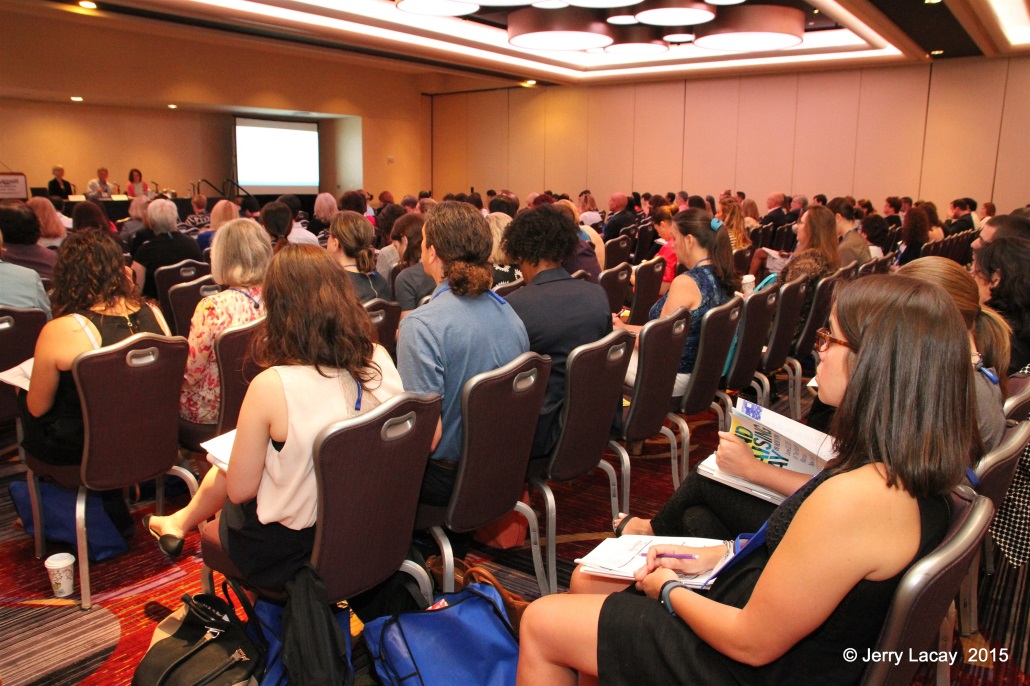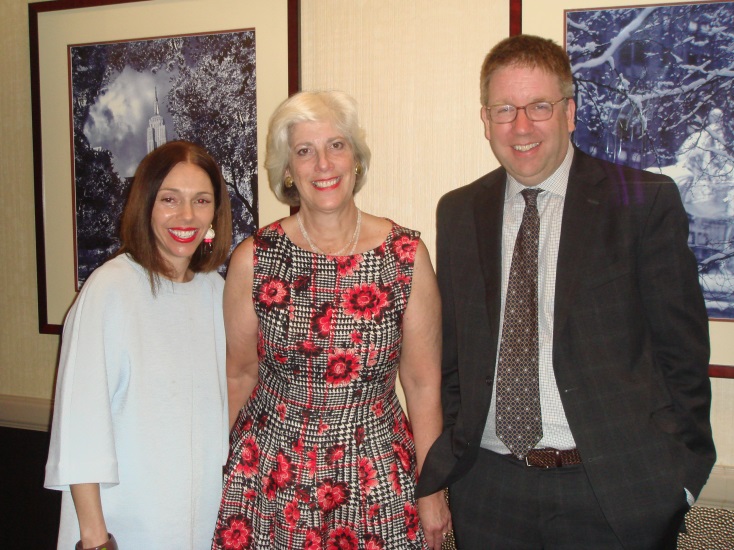Fundriaisng Day in New York City
July 24, 2015 - by Susan Fields, CFRE
Key Concepts from Three Outstanding Educational Programs at Fundriaisng Day in New York City on June 12, 2015
Within the heart of every fundraiser lies a realist, an idealist, and a passionate activist—a person who sees the world as it is, envisions how it should be, and takes action to create change. For the past three and one-half decades Fundraising Day in New York City has provided a venue for fundraisers and nonprofit leaders to come together and learn. Each year they travel from far and wide to share their experience and take part in programs designed to assist them in manifesting the change they are committed to creating within their communities, country, and world.

Attended by more than 1,800 people, this year’s event was the most comprehensive in its history—featuring two education-focused breakfasts, four sessions of fundraising programs on nine tracks, as well as a series of interactive workshops held throughout the day. Attendees had the opportunity to network with colleagues and explore the services offered by more than fifty exhibitors in the Solutions Center as well as sign up for mentoring sessions in a special section set aside for personalized resume review and career coaching. In addition to the special CFRE track, newcomers to the field were offered the opportunity to earn a Fundamentals in Fundraising Certificate in just one day. The three programs described below are just a sampling of the wealth of wisdom and information shared at this premier fundraising conference dedicated to the passion and enthusiasm of those very special people who have chosen fundraising as their life’s work.
_____________________________________________________________________________
Personalized Philanthropy: Crash Your Fundraising Matrix And Make a Real Shift to Donor-Focused Giving
“Philanthropy that focuses on donor interests is a rarity!”

Steven L. Meyers, Ph.D. Vice President, Center of Personalized Philanthropy,
American Committee for the Weizmann Institute of Science
In this compelling program, Steven Meyers, Ph.D. challenges his audience to recognize that their meticulously organized fundraising initiatives often ignore personal donor interests. He points specifically to deferred gift instruments such as bequests and trusts which marginalize donors by placing them outside the traditional “major donor clubs” enjoyed by cash contributors. In order to bring donors closer to the impact of their gifts, Steve has created three Personalized Gift Designs.
-
Virtual Endowment – this instrument encourages a donor to support a scholarship or program long before he/she may be capable of making a substantial gift. The donor agrees to underwrite the cost of a program that ignites their passion through an annual gift over a specified number of years—with a pledge for a future gift (often a bequest or trust) to endow the program in perpetuity.
-
Philanthropic Mortgage – with this vehicle the donor makes an annual gift “over and above” the yearly costs of a program he/she is supporting—with the surplus used to build an endowment designed to sustain the program permanently. One can think of the Philanthropic Mortgage as a pledge to be paid out over time, with a portion of the gift used to support the expenses of the program until the endowment is fully funded.
-
Step-Up Gifts – gifts of this type allow the donor to fund an endowment or chair at different levels over time. For instance an endowment can initially be funded as a “Masters Scholarship” at the $100,000 level with the opportunity for the donor to gradually add to the fund, moving it to a “Doctoral Scholarship” at the $250,000 level, and possibly a “Professorial Chair” at $1 million.
Each of these “Killer Apps”, as Steve refers to them, engages the donor through their interests, and, at the same time, allows them to envision future giving in the form of large outright or planned gifts. At the same time, the donor can join the prestigious ranks of the major contributors of the institution as opposed to having his or her planned gift relegated to the hinterland of a Legacy Society.
Myth Busters: Direct Response Edition
“Although your mission is unique, the way your raise money is not!”

(l-r) Moderator, Lisa Maska, CFRE, Partner, Lautman Maska, Neill & Company
Panel: Bonnie Catena, Connector-in-Chief, Catena Connects
Larry May, Senior Vice President, Strategic Development at Infogroup
Jann Schultz, Senior Director, Integrated Fundraising and Communications.
The myths that fundraisers buy into are often humorous in hindsight. These erroneous beliefs masquerading as truth have become mantras chanted throughout the hallways of many nonprofits—often to their financial detriment. According to this panel of direct response mail experts, studies have determined that every one of these frequently-touted beliefs is false.
Myth #1 - Too much communication will drive donors away!
Just the opposite is true! More mailings mean more money raised and higher retention rates—in spite of complaints from a minority of donors. Studies show that giving drops when six to eleven months are allowed to pass after a first gift is made.
Myth #2 - Direct mail appeals only end up in the recycling bin!
Based upon Blackbaud’s 2014 Charitable Giving Report, only 6.7% of fundraising revenues were generated online—with direct mail still responsible for the “lion’s share” of contributions made my individual donors. In fact, as much as 25% of new donor on-line giving is motivated by direct mail appeals.
Myth #3 - You are your target market!
Fundraisers think of their organization in a business context—while donors contribute based upon their emotions. This requires that marketing materials be geared to the feelings of the donor as opposed to the logic of the fundraiser.
Myth #4 - By asking our donors how many appeals they want, we can mail less and stop aggravating them!
What people say they like and what works for fundraising are usually opposites. Focus groups are usually wrong. People lie on surveys. Donors hate telemarketing, but it works anyway!
In fact, listening to donors regarding direct mail hurts income and retention as few donors follow any real giving pattern. Less mail—less money—it’s that simple.
Myth #5 - Lapsed donors have lost interest in our cause!
Donors don’t keep track of how often they give to your organization, and we most usually have no idea about what motivates their behavior. Try putting more effort into reclaiming lapsed donors by making it a goal to reactivate as many lapses as you gain new donors.
New York Board Giving: Adding Facts to Anecdotes
“Building a Happier and More Generous Board”

Nancy Raybin, Senior Consultant and Principal, Marts and Lundy (center)
Fred Van Sickle, Chief Development Officer, Institute for Advanced Study
Sarah Widoff Williams Leader of Analytical Solutions & Consultant, Marts and Lundy
This summer Marts and Lundy, a leading philanthropic consulting firm, will be announcing the most recent findings from its third research project on board giving among nonprofit organizations in the New York area. Building on the findings from previous studies, this research further explores the characteristics that correlate to higher board giving, as well as increased fundraising totals overall. The results will bring into sharp focus the strategies and tactics nonprofits can use in optimizing board performance. This highly interesting program discussed various trends regarding board development based upon research to date:
-
Bigger is better! Boards with more than 30 members tend have higher overall giving records than smaller boards.
-
Boards with wealth raise more money. In fact, 80% of the organizations studied indicated that wealth was an important criteria in recruitment.
-
Campaigns Reveal Leaders. Boards give more as campaigns move forward.
-
Give, not get! Stress board giving as opposed to getting.
-
Set Terms—but not term limits! This allows your organization to maintain flexibility regarding how long members remain on its board.
-
Include the Director of Development in recruitment! Boards tend to raise more money when fundraising leadership has a role in recruiting.
-
Build a pipeline of candidates! Organize a robust process five-years out to allow for long-range planning.
-
Provide an orientation program for new members! When members understand their role, it results in increased giving.
-
Healthy engagement leads to a happy marriage! Encourage members to participate in fundraising activities.
Industry Articles
July 2022
March 2021
When a Woman Is “The First,” Can She Also Be “The Best”?
June 2020
Recurring Gifts — If You Don't Ask, You Won't Recieve
March 2020
DMAW WEBINAR: Fundraising in the Middle of a Pandemic
June 2018
We entered muggles. We left magicians.
June 2018
The Magic Your Organization Needs
April 2018
5 Sure-fire Ways to Increase Response Rates
September 2017
Red, Blue or Indifferent: The Election Changed Fundraising
July 2017
It’s July: Do You Know Where Your 2018 Direct Response Budget Is?
June 2017
7 Ideas For Multi-Channel Break-Throughs
November 2016
8 Years of Uncertainty is Enough
September 2016
Direct Mail Premiums: Pros and Cons From a Former Pro
August 2016
July 2016
Podcast on On Direct Response Fundraising – with guest Lisa Maska
June 2016
Giving USA: 2015 Was America’s Most-Generous Year Ever
May 2016
Philanthropy: Make Your Mother Proud
June 2015
April 2015
Taget Analytics | donorCentrics™ Index of Direct Marketing Fundraising 2014 Results
March 2015
Communication is Key to Saving Money
February 2015
The 2014 Charitable Giving Report
February 2015
Obama Budget Again Calls for Limit to Charitable Deduction
November 2014
Charitable Giving: How to evaluate and support good causes
November 2014
September 2014
The Science Of A Donor Acquisition Package
July 2014
Consider the Environment. Print this.
July 2014
"Pink Slips" Win Big At MAXI Awards
June 2014
May 2014
Education Opportunities for Non-Profit Executives
March 2014
Member Spotlight: Emerging Leader
February 2014
September 2013
30 Brilliant Bits of Online Fundraising Wisdom from the Experts
August 2013
Building a Stronger Bridge: Conference Volunteer, Tiffany Neill Looks Ahead
June 2013
Non-Profit Fundraising and Marketing in a Multi-Channel World
June 2013
Invest in Marketing and Fundraising to Encourage Innovation
November 2012




